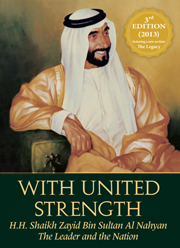Book contents
- Frontmatter
- Contents
- Note on Transliteration
- Abbreviations and Acronyms
- Foreword
- Introduction
- Part I The Heritage
- Chapter 1 The Arabian Tribe
- Chapter 2 A Turbulent Era
- Chapter 3 The Ruler's Representative in Al Ain
- Part II The Transformation
- Part III The Union
- Part IV The Legacy
- Conclusion
- Notes
- Select Bibliography
- Index
- Plate Section
Chapter 1 - The Arabian Tribe
from Part I - The Heritage
Published online by Cambridge University Press: 05 September 2014
- Frontmatter
- Contents
- Note on Transliteration
- Abbreviations and Acronyms
- Foreword
- Introduction
- Part I The Heritage
- Chapter 1 The Arabian Tribe
- Chapter 2 A Turbulent Era
- Chapter 3 The Ruler's Representative in Al Ain
- Part II The Transformation
- Part III The Union
- Part IV The Legacy
- Conclusion
- Notes
- Select Bibliography
- Index
- Plate Section
Summary
In November 1968, the United States Consul General in Dhahran, Saudi Arabia, wrote in confidence to Washington of his first meeting with the young, new Ruler of Abu Dhabi, Shaikh Zayid Bin Sultan Al Nahyan. Lee Dinsmore was immensely impressed with the Shaikh's acuity, his animated and dramatic way of speaking and his obvious political sagacity. The Consul observed, “…he is seen…objectively as a power to be reckoned with because of his intelligence, his money, his willingness to use it to gain support.” He hinted that he found it hard to be objective, being easily swayed by the Ruler's magnetic appeal. “Sheikh Zayed of Abu Dhabi is animated, a spinner of yarns, gesticulating and changing facial expressions, using earthy parables to make a point.” But in what was a short telegram, he made one point with some emphasis. At the start of his report, Dinsmore stated that this was a man who “has also lived simply the life of a desert Sheikh,” and he stressed that others whose judgment he trusted had told him that “Zayed is a capable, strong and straightforward desert Arab.”
For Dinsmore and his superiors in the Department of State, being a “desert Arab,” a Shaikh who had lived as Zayid did, among his people in the harsh and rigorous conditions of the Arabian desert, meant acquiring over time a certain kind of character, making him an honorable man to be reckoned with. The term was used as a kind of shorthand.
- Type
- Chapter
- Information
- With United StrengthHH Sheikh Zayed Bin Sultan Al Nahyan: The Leader and the Nation, pp. 13 - 36Publisher: Emirates Center for Strategic Studies and ResearchPrint publication year: 2013



